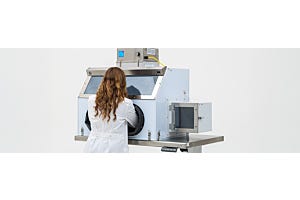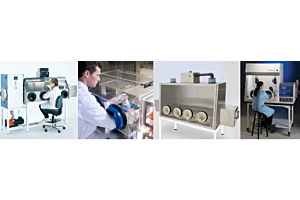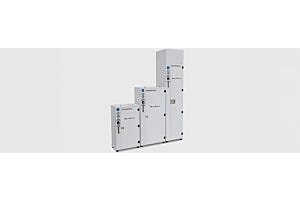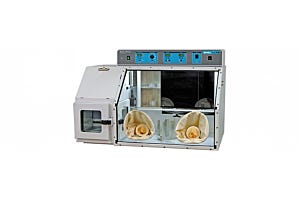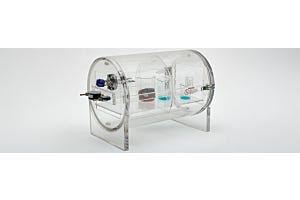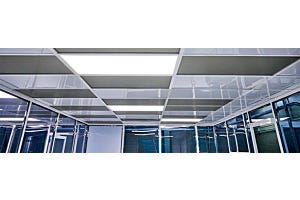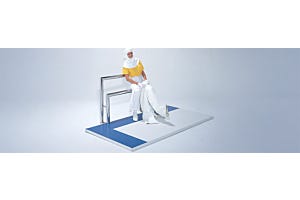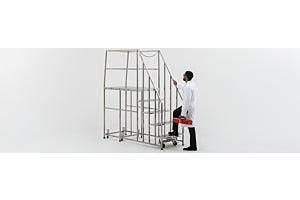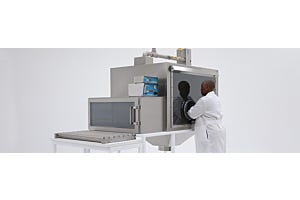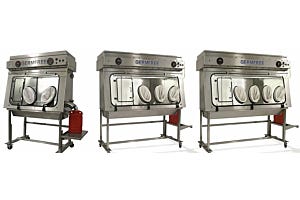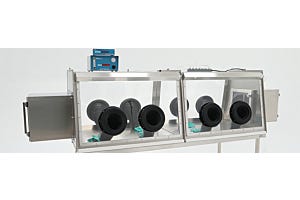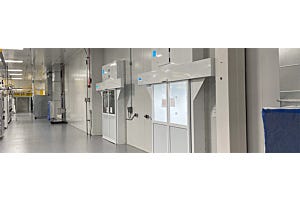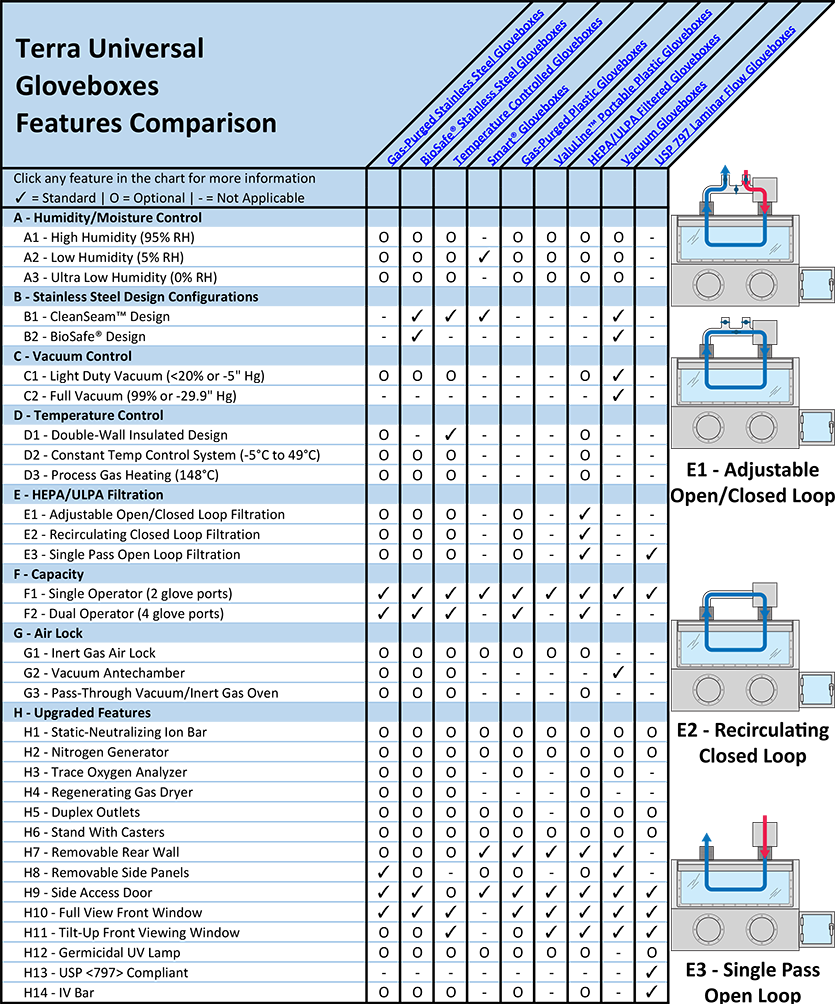
A - Humidity/Moisture Control
(back to chart)
A1 - High Humidity (Above Ambient to 95% RH)
Terra’s Humex™ 2 humidity controller is suitable for a wide range of above-ambient target humidity levels and is cross-compatible with many other Terra systems. When paired with Terra’s Dual Purge and NitroWatch systems, chamber RH is adjustable for higher or lower RH levels in the glovebox.
The Humex 2 uses an inline humidity sensor installed inside the enclosure to monitor the relative humidity (RH) level. As soon as the %RH falls below a user-selected threshold, a relay inside the Humex activates the heater and a solenoid valve for water vapor. The low-volume steam output helps to minimize water condensation. Once the %RH set-point is attained, the Humex turns off the heater and water flow.
A2 - Low Humidity/Oxygen (5% RH)
Applications requiring low humidity down to 5% RH can be configured with manual flow-meters or Terra’s automatic gas-purge control systems. Terra offers control systems for different applications and budgets.
Dual Purge™ & NitroWatch™: Terra Universal's Dual Purge™ and NitroWatch™ work together to fully automate moisture control inside a glove box or similar enclosure. This automatic Nitrogen purge control maintains use-specified sub-ambient RH set-point down to 0% ±1.5% RH. The variable-purge system uses high/low flow settings to conserve nitrogen. Programmable logic gives users complete control over warning alarms and other system functions for worry-free operation. The system can be upgraded to include built-in data logging.
Smart® glovebox system: The Smart® control system offers a simplified, lower-cost alternative to the Dual Purge and NitroWatch, ideal for enclosures less than 6 cubic feet. The system features a mini automatic control module mounted to the side of the glovebox. It includes a built-in RH Sensor and LED display to provide automatic RH setpoint control down to 0% RH with binary (on/off) gas flow. Low moisture conditions are maintained by automatically controlling the flow of dry purge gas, generally nitrogen, into the glove box. The automatic RH set point control minimizes necessary supervision and increases the efficiency of N2 gas consumption, cutting nitrogen costs up to 78% when compared to a manual flow meter gas delivery system. The system can encounter limitations and inefficiencies with gas distribution and RH uniformity in chambers larger than 6 cubic feet.
Flow Meter: A manually controlled flow meter offers the lowest up-front cost for RH control. It is most suitable for smaller gloveboxes that do not require much nitrogen gas or those that require minimal supervision. Manual control means humidity control is more prone to human error and not as efficient with the consumption of inert gas, which can lead to high operating costs and damaged materials.
A3 - Ultra Low Moisture/Oxygen (<1% RH)
Critical applications may require moisture concentration levels below 1% RH, which can be measured in parts per million (PPM). Plastic gloveboxes are generally not suitable due to hygroscopic and permeable material properties, which allow moisture and oxygen to leak into the enclosure. Stainless steel gloveboxes offer the best moisture impermeability, making them ideal for ultra low moisture/oxygen applications such as organometallic chemistry, hydrophilic chemical handling, lithium battery production, microelectronics manufacturing, and hemoglobin research.
Gas purging for ultra low moisture/oxygen systems also requires a high volume of nitrogen (or other inert process gas). Gloveboxes and airlocks configured for negative pressure can use vacuum cycling to reduce nitrogen consumption and more rapidly remove moisture and oxygen-rich air.
Even with a plentiful supply of inert gas and a vacuum pump system, reaching ultra low levels with a manual purge control process can be extremely time consuming and require constant supervision. Terra offers a number of automatic purge systems and accessories to improve the efficiency and effectiveness of ultra low moisture/oxygen gloveboxes:
The extreme sensitivity and precision of the DewWatch™ moisture control unit makes it suitable for the most demanding applications. It operates over the -80 to +20 degree C dew point range, which is equivalent to 0.5 PPMV to 23,000 PPMV in gases at 1 atmosphere. It interfaces with Terra's Dual Purge™ variable gas-flow system for completely automatic nitrogen purging.
Trace Oxygen Analyzers are perfect for high-precision oxygen detection inside a glovebox or similar enclosure. They are ideal for applications in which even minute concentrations of oxygen can degrade parts. Zirconium-oxide or electrochemical fuel cell sensor provides long service life, ppm-precision, and rapid response time for increased productivity.
The AtmosPure Re-Gen Gas Purifier produces an ultrapure inert atmosphere for materials sensitive to moisture and/or oxygen by circulating an inert gas and removing oxygen and moisture inside the box. The Purifier has the capacity to remove up to five liters of oxygen (13,500 ppm) and 660 grams of moisture (18 million ppm) at standard temperature and pressure (STP). Depending on the application, glove box liner material and frequency of use, regeneration may be necessary only once every one to three months and completed in only 13 hours.
B - Stainless Steel Design Configurations
(back to chart)
Stainless steel glove boxes are well suited for broad chemical compatibility, sterile-friendly cleaning, and impermeability to moisture/oxygen.
B1 - CleanSeam™ Design
Continuous Seam Welds: Glove boxes with CleanSeam™ design feature a fully welded single piece enclosure with seamless interiors to eliminate hard-to-clean cracks and crevices that can harbor contaminants. The continuous-seam welds are ground smooth to simplify cleaning and sterilization.
B2 - BioSafe® Design
Meets Aseptic Requirements: BioSafe glove boxes are ideal for life science applications and exceed cGMP, IEST, ASTM and ISO 14644-1 requirements. Continuous-seam welds eliminate hard to clean cracks and crevices that can harbor particles and microbes. Round, wide radius corners simplify complete sterilization.
BioSafe® Door with Knife-Edge Seal: BioSafe® Doors are removable for autoclaving and sterilization. A one-piece, heat-formed, non-adhesive gaskets won’t creep or outgas.
C - Vacuum Control
(back to chart)
Vacuum glove boxes are ideal for vacuum cycling and process gas backfilling. This provides a fast, economical way to achieve extremely low moisture and oxygen levels inside the chamber. During each cycle, a vacuum pump connected to the glovebox removes the chamber environment, and with it moisture and oxygen. Once air is removed, the chamber can be backfilled with an inert process gas until the chamber attains neutral pressure. This process is repeated as needed until oxygen or moisture concentration reach the desired level.
Advanced vacuum control modules automatically apply vacuum to maintain a precise set-point. They also help extend the service life of your vacuum pump by allowing continuous pump operation. Repeated starts and stops, especially under existing vacuum pressure, can lead to backstreaming of pump oil into the vacuum line, resulting in contamination and premature pump failure.
Terra also offers a complete line of vacuum pumps for laboratory and cleanroom operations that require clean, quiet performance.
C1 - Light Duty Vacuum (<20% or -5" Hg)
Terra’s stainless steel negative-pressure glove box designs offer a range of benefits for special applications that require only partial vacuum or slight negative pressure. Stainless steel outgasses less than acrylic, is easier to clean, has higher chemical resistance, and is well suited for higher temperature applications. Removable side panels and access doors also make it easy to transfer large equipment and materials. Continuous-seam welded vacuum glove box designs provide easy-to-clean interiors and reduce negative-pressure leak rates.
Application Note: The gloves cannot be used under negative pressure since the port covers must be shut while the chamber is under vacuum. The chamber must be back-filled to atmospheric pressure before materials inside the glovebox can be handled.
C2 - Full Vacuum (99.9% or -29.9" Hg)
Acrylic Vacuum Glove Box designs are built with one-inch-thick walls to hold full vacuum down to 29.9" Hg (99.9% vacuum). These heavy-duty transparent vacuum gloveboxes include a built-in vacuum airlock to allow materials transfer with minimal disruption to the internal controlled atmosphere.
Application Note: The gloves cannot be used under negative pressure since the port covers must be shut while the chamber is under vacuum. The chamber must be back-filled to atmospheric pressure before materials inside the glovebox can be handled.
D – Temperature Control
(back to chart)
D1 - Double-Wall Insulated Design
Double-wall, insulated glove box isolators boost thermal efficiency to create stable process temperatures and decrease the cost of heating and cooling cycles.
D2 - Constant Temperature Control System (-5°C to 49°C)
Constant temperature isolators provide cost-efficient stable heating and cooling cycles, making them suitable for accelerated-life testing of elastomers, fiber composites, and other materials.
Refrigerating and heating temperature control systems offer broad ranges, -20°F to +140°F (-29°C to 68°C). Temperature control systems can be paired with optional gas purge systems for humidity control (5% to 95% RH) and/or HEPA/ULPA filters to provide a low particle atmosphere.
D3 - Process Gas Heating (up to 176°C, 349°F)
Terra Universal’s Process Gas Heater provides a safe and accurate way to enhance a variety of sensitive operations requiring a heated process gas. Its programmable controller ensures safe, clean heating and provides over-temperature protection. Within a matter of seconds, it raises the temperature of the process gas (such as nitrogen, argon, or oxygen) up to 349°F. The thermostatic control ensures temperature stability. Its isolated heating system provides controlled heating without direct contact with the process gas for safe, non-contaminating operation.
The smart programmable temperature controller monitors and responds to gas temperature measured at either the outlet or inside a cabinet, continuously adjusting the temperature profile and guarding against temperature overshoot. A digital readout toggles between the user-defined set point and the actual gas temperature.
E – HEPA Filtered Air Flow
(back to chart)
A filtered glove box uses HEPA or ULPA filtration to enhance personnel and product protection by removing airborne particulates and powders inside the protective enclosure. These glove boxes are commonly used in labs that produce, mix, or package pharmaceutical or chemical powders. The Class 100/10 ultra-low particle environment also makes these units suitable for other material protection applications such as microelectronics, optics, cell culture, medical devices, micropropagation, genomics, proteomics, and cell biology.
Filtration glovebox systems are available in open-loop, closed-loop, and adjustable-flow configurations. They can also be configured for positive pressure to protect products inside the glove box, or negative pressure to protect personnel outside the glovebox.
E1 – Adjustable Open/Closed Loop Filtration
Adjustable-flow filtered glovebox systems offer the greatest versatility and are best for applications that require both open-loop and closed-loop circulation. Adjustable valves let you quickly switch modes and easily connect to external supply and exhaust systems.
E2 - Recirculating (Closed Loop) Filtration
Closed-loop filtration glove box systems continuously filter and recirculate air inside the glovebox, without introducing any ambient air. They are suitable for applications that require both a low-particle and controlled gas atmosphere. They can be combined with a process gas such as nitrogen to maintain a low-moisture, low-oxygen atmosphere inside the enclosure.
Some advantages of a closed-loop recirculating system include energy efficiency and protection from harmful process gases. A closed-loop design recycles preconditioned air or process gases to minimize heating, cooling, and consumption of process gas.
E3 - Single Pass (Open Loop) Filtration
Open-loop filtration glove box systems include an inlet and exit filter. The inlet filter removes microcontaminants from outside air drawn into the glove box. The exit filter captures fine particles from the exhaust, allowing the safe indoor release of exhaust air.
Single-pass configurations introduce filtered ambient air into the enclosure and are therefore not suitable for applications that require a low-moisture, low-oxygen, or similar controlled gas atmosphere.
F – Capacity
(back to chart)
F1 - Single Operator (Two Glove Ports)
Single operator configurations are both economical and compact, well-suited for smaller work areas, portable glovebox field-work, and equipment-dense areas in the lab.
F2 - Dual Operator (Four Glove Ports)
Multi-operator gloveboxes are widely customizable for optimal workflow. Samples often require passage from station to station and are introduced and removed via an air lock, which minimizes disruption of internal cleanliness and low-humidity conditions. Glove ports can be configured to the front, side, and/or rear of a glovebox with appropriate clearance.
One might consider other factors when opting for a larger, multi-operator glove box system. Selecting the ideal glove box system may also require long-term value consideration such as easy cleaning features, operator ergonomics, and upward compatibility.
G – Air Lock
(back to chart)
Airlocks mount on the right or left side of the glovebox to minimize cross-contamination when materials are transferred to and from the glovebox.
G1 - Inert Gas Air Lock
Inert gas airlocks are an economical option to minimize nitrogen loss and contamination inflow when materials are passed through the glove box. The airlock is connected to an inert gas line to purge out ambient air before the inside door is opened to allow materials to transfer into or out of the main chamber.
Inert gas airlocks are available in several configurations to streamline workflow. Airlocks can also be used to interconnect multiple gloveboxes in series.
G2 - Vacuum Antechamber
A vacuum antechamber can provide faster parts transfer than an airlock configured only with inert gas purge. After materials are loaded into the vacuum airlock, the operator uses a vacuum pump to initiate vacuum cycles that quickly remove ambient, moisture-laden air, and back-fill with an inert gas. The operator then opens the internal door from inside the glove box to bring materials into the work area.
G3 - Pass-Through Vacuum/Inert Gas Oven
High-performance vacuum ovens combine heat, inert gas, and negative pressure for the fastest removal of moisture and contaminants from materials transferring into a glovebox. They are designed to allow for easy attachment to the side of Terra’s stainless steel gloveboxes.
H – Upgraded Features
(back to chart)
H1 - Static-Neutralizing Ion Bar
Ionizing bars provide a continuous stream of static-neutralizing ions that minimize electrostatic charges. This helps protect sensitive electronics from electrostatic discharge (ESD) and enhances cleanliness by neutralizing static cling, when charges attract and hold particles to surfaces.
Terra’s ionizing bar uses state-of-the-art technology to generate a balanced stream of positive and negative ions to neutralize surface static charges and safeguard ESD-sensitive materials. Ionizing bars for gloveboxes include one fan per pair of emitters to uniformly distribute ions through the glove box enclosure. The system requires no calibration and automatically maintains ion balance of ± 50 volts.
H2 - Nitrogen Generator
Compact, high-capacity Nitrogen generators require only a compressed air supply for continued nitrogen gas production. On-site nitrogen generation eliminates the cost and inconvenience of a 3rd-party nitrogen tank supplier while also providing as-needed control over the quantity and quality of nitrogen produced. Terra’s N2 generators require no moving parts and consume little energy beyond a stream of compressed air.
H3 - Trace Oxygen Analyzer
Trace Oxygen Analyzers are perfect for high-precision oxygen detection inside a glovebox or similar enclosure. They are ideal for applications in which even minute concentrations of oxygen can degrade parts. Zirconium-oxide or electrochemical fuel cell sensor provides long service life, ppm-precision, and rapid response time for increased productivity.
H4 - Regenerating Gas Dryer
The AtmosPure Re-Gen Gas Purifier produces an ultrapure inert atmosphere for materials sensitive to moisture and/or oxygen by circulating an inert gas and removing oxygen and moisture inside the box. The Purifier has the capacity to remove up to five liters of oxygen (13,500 ppm) and 660 grams of moisture (18 million ppm) at standard temperature and pressure (STP). Depending on the application, glove box liner material and frequency of use, regeneration may be necessary only once every one to three months and completed in only 13 hours.
H5 - Duplex Outlets & Power Strips
Duplex outlets and power strips allow convenient operation of electrical equipment inside a glovebox. GFCI outlets are suitable for areas around liquids to help prevent electric shock and damage to your electrical devices.
H6 - Glovebox Stand With Casters
Terra’s ErgoHeight™ electric height adjustable workstations provide effortless height adjustment without the need to temporarily relocate heavy and expensive process equipment. They are tested by UL to meet the strictest safety and stability standards.
Rigid glovebox stands offer a heavy-duty alternative. They are constructed of all-welded 1.5” steel square tubing for maximum stability. They are available in stainless steel or with a clean and durable powder coat finish.
Optional casters provide mobility to glovebox stands for easy transportation or to clean around the work area.
H7 - Removable Rear Wall
A removable rear wall panel allows for transfer of large equipment into the main glove box chamber, and facilitates cleaning inside the glovebox. Foam gasket around the perimeter minimizes leaks. Removable rear panels are generally not opened while the glovebox is maintaining a controlled atmosphere.
H8 - Removable Side Panels
Removable gasketed side panels allow easy introduction of large process equipment or retrofitting of air locks and adjacent gloveboxes. Stainless steel gloveboxes feature an innovative clamping mechanism with only two screws per side that allows for quick installation in minutes.
H9 - Side Access Door
Side access doors facilitate the transfer of larger equipment that may not fit through a smaller size airlock and simplify cleaning inside the glovebox. They are generally not opened while the glovebox is maintaining a controlled atmosphere.
H10 - Full View Front Window
Full-view gloveboxes combine the full visibility of transparent plastic glove boxes with the strength and processing capabilities of a 304 stainless steel chamber. The entire front side of the glovebox is replaced with a window that includes built-in gloveports. They are ideal for gloveboxes with equipment or operations that require more vertical space.
H11 - Tilt-Up Front Viewing Window
Tilt-up front windows allow convenient transfer of large materials or equipment into a glovebox. They also help simplify cleaning inside the glovebox. Hinges and lift latches make it easier to use than a removable panel that would need to be unscrewed and detached. Tilt-up windows are generally not opened while the glovebox is maintaining a controlled atmosphere.
H12 - Germicidal UV Lamp
A UV sanitizing module neutralizes bacteria, viruses, and mold spores inside the glovebox. UV light is particularly effective when targeting resistant bacteria, mold/fungal spores, and gram-negative bacteria.
H13 - USP <797> Compliant
Laminar Flow Glove Box Isolator (LFGI) designs meet USP 797 and ISO Class 5 for sterile compounding of pharmaceuticals. A HEPA filtration module provides clean, positive pressure air in accordance with ISO 5 requirements. A separate antechamber allows the introduction of materials without contaminating the main work area.
H14 - IV Bar
An IV bar is an integrated rod for hanging IV bags during laboratory processes, pharmaceutical compounding, or medical research applications.




